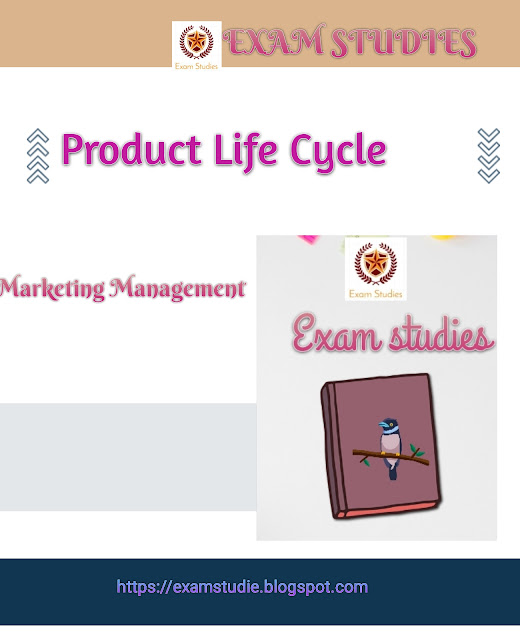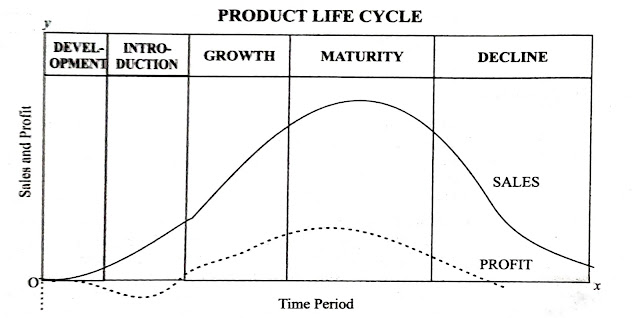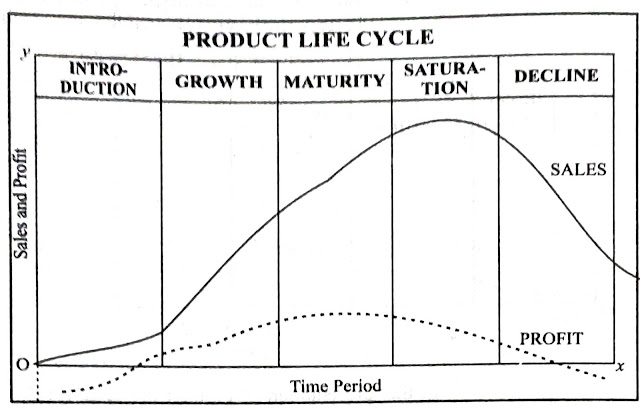Product Life Cycle
Meaning of Product Life Cycle
Definitions of Product Life Cycle
Features of Product Life Cycle
Stages of Product Life Cycle
Different shapes of Product Life Cycle
Length of Product Life Cycle
Meaning of Product Life Cycle( Exam studies)
'Product Life Cycle' (PLC) is one of the most important concepts in marketing management. The concept of Product Life Cycle was developed by Prof. Theodore Levitt and popularised by many scholars like, C. R. Wassen, B. Carthy, D. J. Luck, D. T. Kollat, R. D. Blackwell and others.
Like a human being, all products have certain length of life during which they pass through certain identifiable stages. The product life cycle is a conceptual representation of product ageing process. As the life of a human being can be divided in four stages i.e. childhood, youth, young and old age, in the same manner life of a product can also be divided into four stages, namely:
(i) Introductory Stage
(ii) Growth Stage
(iii) Maturity Stage
(iv) Decline Stage
These four stages of PLC are collectively known as 'Product Life Cycle'. Like human life no product is immortal. The life of a product starts with itsintroduction in thDecline Stagee market for the purpose of sale. The demand of that product is gradually increased in the market and it reaches to its maximum, from where it start declining. Passing of a product through all these stages is known as Product Life Cycle.
Definitions of Product Life Cycle
Definitions are as follows:
According to Arch Patton, "Life cycle of a product is akin to human life cycle from several angles. Like a man the product also takes birth, rapid growth, attains the maturity and then enters the declining stage."
According to Philip Kotler, "The product life cycle is an attempt to recognise the distinct stages in the sales history of the product - sales history pass through four stages. These are known as introduction, growth, maturity and decline."
According to William J. Stanton, "The product life cycle concept is the explanation of the product from its birth to death as a product exists in different stages and in different competitive environments."
According to Lipson and Darling, "Life cycle of market offering is the stages of market acceptance through which a market offering passes from introduction to its market death. The stages in a market offering life cycle are market introduction, market growth, market saturation, market decline and market death."
An analytical study of the above definitions of product life cycle indicates that a particular product is born or introduced, grows, attains maturity and the point of saturation in the market and then sooner or later it is bound to enter in its declining stage and finally reaches the stage of obsolescence, the stage when the product looses its distinctiveness and dies out in terms of both sales and profit margin.
Features or Implications of Product Life Cycle
The meaning and definitions of product life cycle concept highlight the following features of PLC :
1. Every product has the life cycle as every human being has.
2. The life cycle of every product starts from an introduction of the product in the market and it is ceased after passing through the market growth and market maturity stages.
3. The product life cycle denotes that the product passes from different stages at different speed in course of completing the whole cycle.
4. The profits of business firm grow rapidly in the stage of growth and starts declining due to competitive conditions at the stage of maturity. However the sales volume go on increasing.
5. No two products have identical life cycle. It may last from few months (e.g. fashion garments) to several years (e.g. cycle, bread, biscuits, electric appliances).
6. The duration of each stage is different for different products. This duration depends upon the factors such as nature of product, rate of technological changes, competition pressure, etc.
7. It is not necessary that all products go through all stages, some fail at the initial stage (i.e. introductory stage), others may reach maturity stage after a long time.
8. At a given point of time the same product might reach different stages in different market segments. In segment one, it might have touched the peak - height of maturity, in segment two it may be in growth stage, in segment three it may be heading towards the decline.
9. One cannot have a definite line of demarcation between one and the subsequent stage. The succession is one of merging and not of finite calculation.
10. The product life cycle concept provides a useful framework for developing effective marketing strategies in different stages of the product life cycle.
Stages of Product Life Cycle
With the development of product and start of commercial production, life cycle of the product begins. The product life cycle has four stages as shown in the diagram namely: Introduction Stage - Growth stage - Maturity stage and Decline stage. As the product moves through different stages of its life cycle, sales volume and profitability changes from stage to stage. A detailed study of each stage is necessary in terms of its basic features, so that a marketeer make necessary changes in his marketing mix. Product life cycle is simply a graphic presentation of the sales history of a product in distinct stages as illustrated in the following diagram.
PRODUCT LIFE CYCLE
I. Market Introduction Stage
It is the pioneering stage, wherein the product is launched in the market with full scale production and marketing programme. The product is a new one. The new product means, "a product that opens up an entirely new market, replaces an existing product or significantly broadens the market for an existing product." The product has only proven demand and not the effective demand. That is why sales grow at a very lower rate. This stage is characterised by low profit margin, few direct competitors, high production and distribution costs, narrow product line, high prices, limited market, greater emphasis on advertising and sales promotion activities. Following are the prime characteristics of this stage :
1. Low and slow sales: The growth in sales volume is at a lower rate because of:
(i) lack of knowledge on the part of consumers, (ii) delays in making product available to the consumers due to lack of retail outlets,
(iii) delay in expansion of production capacity, (iv) consumer resistance to change over from the established consumption behavioural pattern, etc.
2. High product price: The prices charged at the beginning are the highest possible because of:
(i) low output;
(ii) technological problems,
(iii) heavy promotional expenditure,
(iv) more distribution cost,
(v) less competition,
(vi) sales to high income group customers etc.
3. Heavy promotional expenses: There is high percentage of product failures in this stage due to lack of proper promotional efforts. Thus, it is necessary to prepare and implement the effective advertising and sales promotion programme. A company made heavy expenditure on advertising and sales promotion in order to stimulate the demand.
4. Lack of knowledge: The consumers do not have sufficient knowledge regarding products and even if some have the knowledge, they too hesitate while buying the product.
5. Low profits: Profits may be low because of less sales, heavy expenditure on promotion and distribution of product. Some firms may suffer losses during the first part of this stage.
6. Narrow product line: During introductory stage the product has only one or a few models. So the product line remains shorter. Market area is also limited.
II. Market Growth Stage
Once the market has accepted the product, sales begin to rise and product enters its second stage i.e. growth stage. In this stage the product achieves considerable and widespread approval in market. The sales and profits increases at an accelerated rate. In this stage, effective distribution, advertising and sales promotion are considered as the key factors. Following are the main features of this stage :
1. Rapid increase in sales: During this stage, the sales start climbing up at faster rate because of: (i) consumers have become aware of the product, and they begin to accept the product, (ii) the distribution network has been established, (iii) production facilities are streamlined to meet the fast moving sales, (iv) heavy promotional expenditure, (v) product improvement and increase in number of product items in the product line.
2. Product improvements: In this stage manufacturer improve the product quality and add some new features in the product. The length of product line is enlarged by introducing new versions of the product to fulfill the requirement of different types of customers.
3. Increase in competition: If profit outlook appears to be attractive, the competitors enter the market in large number with substitute products. Competitors have the advantage of entering the market because research and development have already been completed by innovating firm at its costs. Competitors become stronger by coming out with modified products at reduced prices. This compel the originators to further improve the product and bring down the price to nab competition.
4. Increase in profits: In this stage the profits of the manufacturer, distributors and retailers are rapidly increases.
5. Reduction in price: Price of the product is reduced due to large scale economies and also because of the entry of competitors. Prices are also reduced to attract the customers. Thus, price of the product becomes competitive.
6. Strengthening the distribution channel: The channels of distribution are strengthened so that the product is easily available wherever required. Some new channels are used to enter the new market segments.(Exam studies)
III. Market Maturity Stage
Eventually, market becomes saturated because the household demand is satisfied and distribution channels are full. The product has to face keen competition which brings pressure on prices. Though the sales of the product rises but at a lower rate. Profit margin however decline due to keen competition. Followings are the main features of market maturity stage :
1. Sales increases at decreasing rate: Because most of the household demand is satisfied and distribution channels are full, sales continue to increase for a while, but at a decreasing rate.
2. Normal promotional expenses: At the maturity stage the promotional expenses reach a normal ratio to sales. The main theme of advertising in this stage become to popularise the brand name of the product.
3. Uniform and lower prices: Prices charged by the manufacturer are quite lower and uniform with the competitors.
4. Product modifications: Efforts for product modification, improvement in marketing mix or product mix become apparent.
5. Dealer's support: Supply of the product increases more than the demand because on account of considerable expenses made by the competitive firms on sales promotion. This stage require demand stimulation and dealer support.
6. Profit margin decreases: In this stage prices are lowered and promotional efforts made aggressive to face competition. This lowers the profit margins of both the manufacturers and the retailers.
Some scholars believe that this stage has two parts. The first part is known as maturity stage and the second part is known as the saturation stage. Under maturity stage:
(i) Sales increases but profits begin to decline.
(ii) Competition intensifies and the product differentiation diminishes.
(iii) Supply starts exceeding the demand.
(iv) Marketing expenses start rising and price of the product starts decreasing.
Whereas under the saturation stage:
(i) Sale of substitute products in the market start rising.
(ii) Cut throat competition prevails in the market.
(iii) Product is matured and need something new to replace it.
IV. Decline Stage
The final stage of the product life cycle is known as a market decline stage. It is the terminal stage, sooner or later actual sales begin to fall under the impact of new product competition and changing consumer behaviour. The sales and profits fall down sharply and the promotional expenditure has to be cut down drastically. Following are the main features of this stage:
1. Rapid decrease in sales: As the product is quite old and new one are available, so there is change in the trend. People are interested in buying something new. The sales, therefore, fall sharply. The total number of the firms in the market comes down. For example, the number of companies manufacturing calculators is much less than what it was in 1970s and 1980s. Over stocking of products in the market has become a major problem.
2. Further decrease in prices: Rapid decrease in sales create a fear and there will be intense competition among the manufacturers to sell the stock at the earliest which compels the manufacturer to reduce the price of their products. Price becomes the competitive weapon.
3. No promotional expenses: Because of saturation, advertising and sales promotion efforts lost their effectiveness. Therefore, many companies reduced their advertising budget. Distribution network also reduced to the minimum. Only selective promotional expenses are incurred.
4. Suspension of production work: When decline in sale is permanent and the product ultimately disappears from the market. At this stage it is advisable to stop the production of the product and switch on to other products.
The above discussion concentrates on the life cycle of a product beginning with its introduction into the market and ending with its decline in sales leading to obsolescence.
Different shapes of Product Life Cycle
Philip Kotler in his book, 'Marketing Management explained the five staged product life cycle. According to him, product life cycle (PLC) is the course of a product's sales and profits over its lifetime. It involves five distinct stages:
(1) Product development stage;
(ii) Introduction stage;
(iii) Growth stage;
(iv) Maturity stage, and
(v) Decline stage,
Graphical representation given below:-
1. Product Development stage: The company finds and develops a new product idea. During this stage of product development sales are zero and there is only investments.
2. Introduction Stage: It is a period when sales grow at a low rate. In the later part of this stage firm can earn profit but during this period firms generally suffer losses because of heavy developmental and promotional expenses.
3. Growth: It is a period of rapid market acceptance and increasing profits.
4. Maturity: It is a period of slowdown in sales growth because the product has achieved acceptance by most potential buyers. Profit starts declining.
5. Decline: It is the period when sales fall off and profits drop.
Five Stages Product Life Cycle
Prof. W. J. Stanton has explained the life cycle of a product from its birth to death as it exists in different stages and in different competitive environments. The product life cycle may move through five distinct stages, such as
1) Introduction stage
2) Growth stage
3) Maturity stage
4) Saturation stage
5) Decline stage











![Himachal Pradesh - General Knowledge (H.P.-GK) Important multiple choice questions [MCQ] Series-G [PDF]](https://blogger.googleusercontent.com/img/b/R29vZ2xl/AVvXsEihP5ys_xY1amJSiIEX-cY2NLnL0-9UBNpv2MTUAeFLcs2pnfZKTYrt7Qd-n_r7M4evoPfvEdhHqdfZJOZSq9KYkrGcH_xqghVowGepqKTjk95dgtUVABcsuzhRcsWto5IrCi3jfZcRgnUztoalEsVLXewOeyf2k3keJIRTSQvEIfkRVVhFXlOSAxAK/w72-h72-p-k-no-nu/Untitled.png)
![Himachal Pradesh - General Knowledge (H.P.-GK) Important multiple choice questions [MCQ] Series-E [PDF]](https://blogger.googleusercontent.com/img/b/R29vZ2xl/AVvXsEgvoEofOEWgV2ZbKnHN0TIymi5Ri4OkMlEtZSBr-uBeGEIfoHH7VbEK_Znb2bog2mo5eWSYvhgC3VT2gUixmn_it7TP13EVdxDKI21dEHngzbUbjy0myZ6X86bS6IaqkkweK-uwRYQdW3GLNFQtUkWJhmffquskJFEii-4T0hAtUzte3rXwegACr8hy/w72-h72-p-k-no-nu/Series%20E.JPG.webp)
![Himachal Pradesh - General Knowledge (H.P.-GK) Important multiple choice questions [MCQ] Series-D [PDF]](https://blogger.googleusercontent.com/img/b/R29vZ2xl/AVvXsEg9VldQ-XZ0MMTk4_GjvWCEGKlUs3CVQAFbyqJbBsylLvzF6tGZHY18wjUAv-1ZhFh1jKWDtDfVzFOqUTbvjxs6eHM0ctieIeuxPJadN77BsFpuHkHqlkx_O47iDIZaxCQzXMptimaiWmiYXvqeDrg94tRV9KFRIkVOtS_kd05hZpC8xjp70CoTaG8R/w72-h72-p-k-no-nu/Series%20D.JPG.webp)


0 Comments